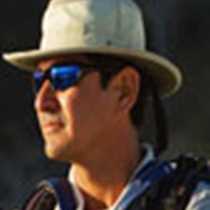Genovesa, or Tower Island, is home to more than one million seabirds. Our highlights here were diverse. We spotted Nazca boobies, red-footed and blue-footed boobies, gulls and owls.
Our adventure began at the famous Prince Philip’s Steps, where we were surrounded by Nazca boobies, red-footed boobies, and frigatebird chicks. My colleague Gaby was able to find the elusive short-eared owl. Lucky for us, she spotted it hiding from the strong sea breeze and all of us felt rewarded to have a unique view of the camouflaged diurnal raptor.
Back aboard the National Geographic Endeavour, we prepared for our last snorkeling outing. Today in the undersea realm, we had close encounters with a few Pacific green turtles, fur seals, hammerheads sharks, and manta rays. Seeing these creatures up close brought out our excitement and admiration.
Afterward, we returned to the ship for our last delicious lunch, provided with pride by our culinary staff. We were then ready to start off our next adventure: a wet landing on a white coralline beach in Darwin Bay, named by William Beebe in honor of the great naturalist who re-directed human thought, Charles Darwin.
At low tide we walked over a platform surrounded by birds of all kinds and their chicks. We were moved by the sight of so many adult seabirds taking care of their chicks until the day they can fend for themselves. We were also happy to find a few marine iguanas, which are smaller and darker on this Northern Hemisphere island than elsewhere. Taking this walk was like being transported back in time. Birds flew all around us, like in prehistoric times, and lava formations resembled the first foundation of Earth.
Later, it was time to return to the ship and reminisce about the many experiences of such a wonderful week. As we looked back and gazed at the islands for the last time, this place now seems timeless to us. It is now deep within our hearts. Our experience has been unforgettable on these special islands, where the wildlife has no fear of us and allows us to realize that we are not so different from them. Instead of “humanizing the animals,” we “animalized the human,” by perceiving our surroundings with all our senses so that we can become one with nature as we once were. United by this invisible mysticism, we have all bonded like a family.
At the end of our journey, we hope to stay in touch and we hope that the experience of our guests will stay with them for a lifetime.







